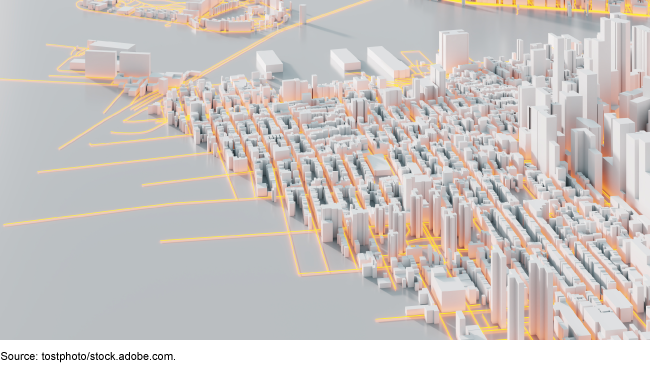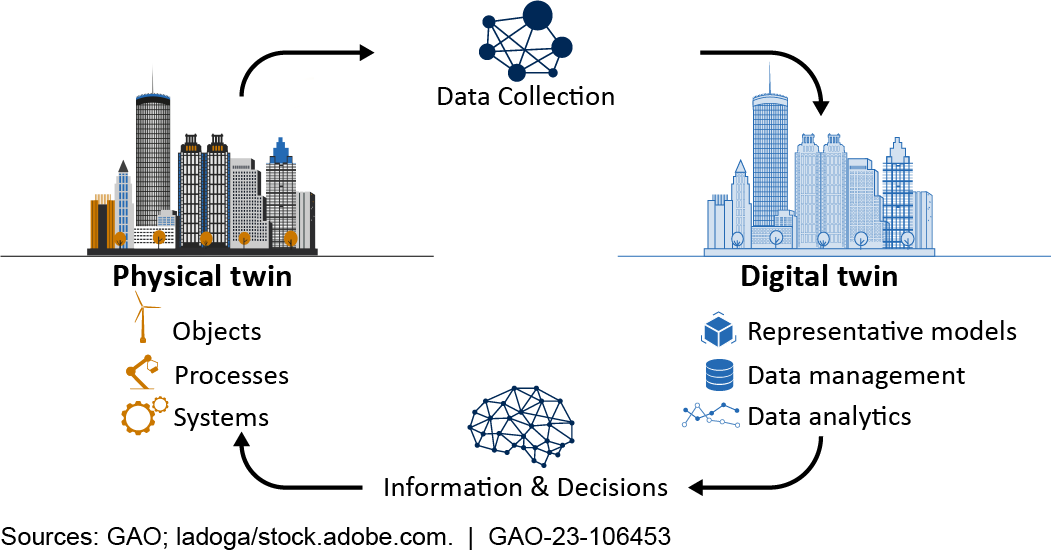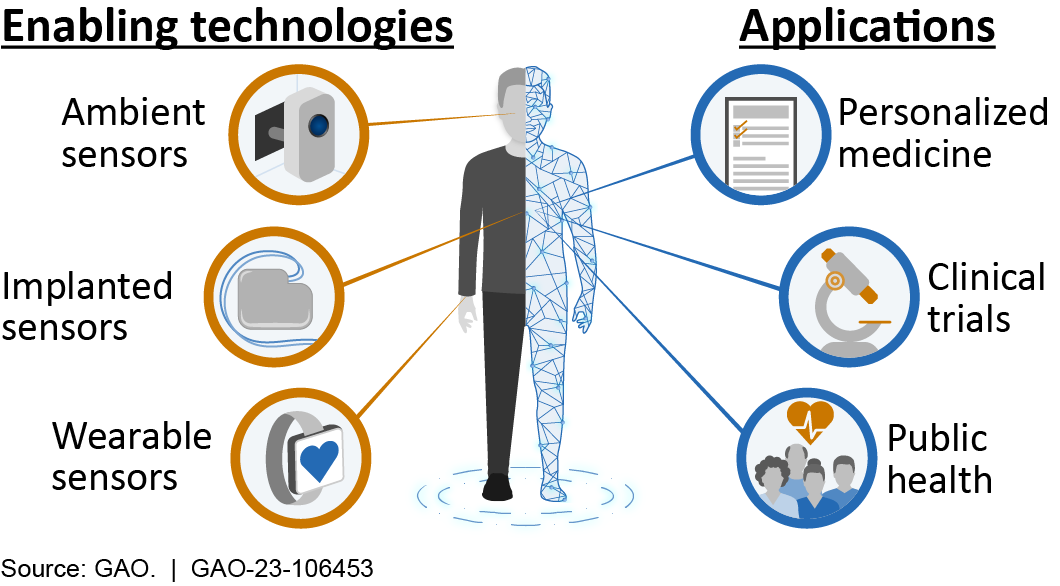Science & Tech Spotlight: Digital Twins—Virtual Models of People and Objects
Fast Facts
"Digital twins" are virtual representations of physical objects, processes, or systems—like factories, traffic patterns, and even people. A digital twin is used to predict how changes may affect its physical counterpart. For example, a city could use a digital twin to monitor its energy use to plan for extreme weather.
Digital twins have benefits, like making manufacturing more efficient, but they can raise technical, security, and ethical questions. For example, a doctor could use a patient's digital twin to detect health problems, but there may be data privacy issues. We reviewed some of the opportunities and challenges of this technology.
A digital rendering of a city

Highlights
Why This Matters
Digital twins are virtual representations that can mimic and predict the performance of their physical counterparts. Many industries use them to reduce costs, improve engineering design and production, and test supply chains. But some applications—like creating a digital twin of a person—raise technical, privacy, security, and ethical challenges.
The Technology
What is it? Digital twins are virtual representations of people or physical objects, processes, or systems, ranging from vehicles to industrial plants to clinical trial patients. These "living" computational models integrate with data from a physical twin, such that any changes made to the physical twin can automatically lead to changes in the digital twin (see fig. 1). Digital twins can be used to remotely maintain or monitor the physical twin, or predict how it will perform.
Digital twins can be applied across many fields. For example, they can help more efficiently design aircraft parts, predict and avoid supply chain disruptions, and improve traffic safety. They could also monitor living systems or predict hypothetical effects on them for applications in health care, agricultural management, and climate forecasting.

Figure 1. Example of the integration of physical and digital twins.
How does it work? Digital twins rely on multiple existing technologies, including the Internet of Things, a network of interconnected "smart" devices that exchange information and collect large amounts of data. Sensors built in or placed on the physical twin or around its environment can collect data continuously. These sensors transmit data that update the digital twin through technologies such as network interfaces and cloud platforms, depending on the physical twin and its location. For example, sensors in a factory may transmit data to a digital twin via local wireless networks, but sensors in public spaces may require cellular networks for adequate connectivity.
Digital twins use these data to dynamically change along with the physical object in real time. This allows users to interact with a 3D visualization, monitor changes, and predict the effect of future events. For example, digital twins of smart cities can be used to predict how extreme weather events will affect the power grid, and what cascading effects might follow. Digital twin data can also be analyzed using artificial intelligence and machine learning to test different scenarios or make predictions for the physical twin. For example, machine learning could automatically recognize an abnormal pattern in a patient's digital twin, enabling a quicker diagnosis and improved treatment (see fig. 2).

Figure 2. Examples of how digital twins can be used in health care.
How mature is it? Though the term “digital twin” was coined around 2010, NASA engineers originally applied the concept by building physical and computational models of the Apollo 13 mission vehicles on the ground that were adapted to match the vehicles’ changing conditions in space. Today, the use of digital twins is growing, owing to advances in high-performance computing, rapid data analysis, and smart sensors. Applications in industry include improving operations and predicting or mitigating the effects of manufacturing disruptions.
For example, one company builds digital twins of wind turbines to help manufacturers identify potential problems before scaling up production. The U.S. Navy uses digital twins of shipyards to help inform officials of expected project costs. Digital twins are also being used to more efficiently rebuild areas of a Ukrainian city destroyed in the conflict with Russia, enabling officials to forecast reconstruction costs and improve the city’s infrastructure and resources. In the U.S., a digital twin of the Orlando region allows local government, companies, and nonprofits to simulate and visualize the effects of scenarios such as climate change and new transit routes.
Digital twin technology is less mature in the biological sciences, primarily due to the complexities of living systems found in areas such as health care, agricultural management, and the environment. Researchers are studying whether digital twins of people could improve health care by predicting patient response to different therapies in clinical trials or by diagnosing health conditions using pattern recognition through machine learning. Moreover, the Food and Drug Administration’s strategic plan notes the technology’s cost-saving potential in evaluating medical devices prior to patient use. In addition, a European Union (EU)-funded project plans to use digital twins for personalized medicine by simulating the electromagnetic activity and physiology of patients’ brains to help treat diseases such as Alzheimer’s and epilepsy.
Researchers are also exploring applications in agricultural management by using digital twins to study bee colonies to control honey production and examine the biology of fruit to improve transport and storage. The EU and the National Oceanic and Atmospheric Administration have initiated projects to build digital twins to monitor global environmental conditions.
What are some concerns? Cloud computing services, software, and other products to implement digital twins have potential legal, ethical, and technical issues. According to experts, ethical concerns over data ownership and privacy could result in low public trust. This could occur, for example, if a pharmaceutical company sold health-related data from digital twins without consent. Technical issues such as data quality or accuracy could also reduce public confidence when digital twins are used for decision-making. For example, if data used to train machine learning do not accurately reflect the characteristics of a patient, the predictive analysis by the digital twin could be misleading or even discriminatory.
Digital twins require many interrelated systems and networks for large-scale data collection and transmission, which poses interoperability and cybersecurity issues, according to researchers. Cybersecurity risks could include unauthorized access or modifications to the real data, compromising confidentiality and public trust. Additionally, relevant U.S. infrastructure may not be adequate for such high-performance computing. Researchers have highlighted that the high upfront costs for using digital twins may create access and affordability issues for less affluent city governments or patients whose health insurance does not cover its use.
Researchers also emphasize that standards and regulations are not fully developed to address digital twin implementation, especially for more complex applications. Currently, users rely on a patchwork of standards for data management, security, and networking established by organizations such as the National Institute for Standards and Technology and the International Organization for Standardization.
Opportunities
- Manufacturing and engineering efficiency. Digital twins monitor in real time to help avoid potential problems, optimizing manufacturing and engineering projects and reducing costs.
- Improved health care. Digital twins could help facilitate predictive and personalized medicine to improve patient outcomes and reduce some health care costs.
Challenges
- Privacy and ethical issues. Security, bias, and data ownership issues, especially for digital twins applied in health care, can reduce public trust in the technology.
- Technical and infrastructure barriers. Digital twins are difficult to scale up for more complex systems, and the current U.S. network infrastructure may not be adequate for expanded use.
- Economic costs. Digital twins can be costly to develop, leading to potential inequities in their use.
- Standards and regulations. Existing standards and regulations for digital twin implementation may not be adequate to address their application in complex systems, especially biological ones.
Policy Context and Questions
- What options exist for dealing with ethical or equity issues that digital twins could raise, especially in areas such as health care?
- What steps could help mitigate potential security and privacy risks associated with digital twin technology?
- How could standards and regulations be further developed for digital twin technology, especially when applied to individuals?
For more information, contact Brian Bothwell at (202) 512-6888 or bothwellb@gao.gov.
